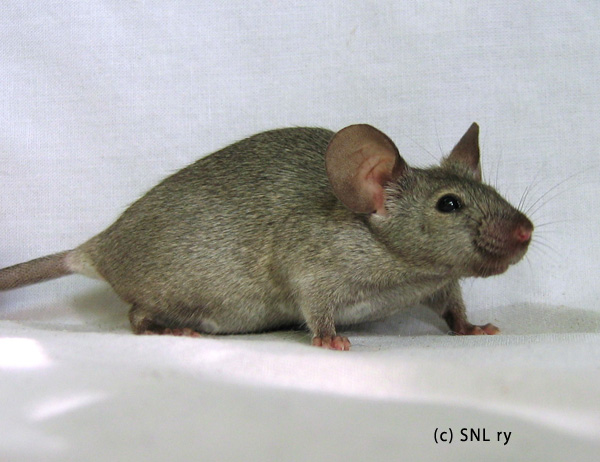Varieties
Ticked
Grey Agouti (gr-ag)
A/A B/* cch/cch D/* P/*, or
A/a B/* cch/cch D/* P/*
This variety was formerly called "silver agouti".
"This variety is like the normal agouti except the golden brown pigment of the latter is replaced by silvery grey. Colour to be bright silvery grey evenly ticked with black. Undercolour deep slate. Belly to be silvery grey as close as possible to the top. Feet to match top. Eyes black."
Breeding information below the pictures.

|
SH grey agouti doe (Click the pic for a larger image.) |
Quick Look
Genetically grey agouti is an agouti mouse with two chinchilla genes. The colour should be silvery grey with black ticking evenly distributed throughout the body.
Anyone interested in breeding grey agouti should try to find at least one grey agouti to start with. There are grey agouti breeders in several European countries. The variety is quite rare in Finland, but it exists. Trying to create grey agouti using chinchilla is uncertain, as the vast majority of chinchilla mice are probably based on Aw and may not have the desired gene A at all.
Most common faults include brownish colour, light belly colour, concentration of ticking or “muddy” (not clear and sharp) ticking. Breeding grey agouti together with other cch-based varieties should be avoided, as these may ruin the belly colour of grey agouti and/or introduce unwanted umbrous factors to the variety. Agouti is also not a good option, because it may cause brownish shade. Therefore, trying to get rid of colour faults in grey agouti by breeding it to some other variety is difficult; most matings of this sort only damage the colour. Best way to breed grey agouti is to get a pure line and breed out possible faults with selective breeding.
To improve the type of grey agouti, an outcross to a show type pink eyed white is possible. The background of the pew should be known so that it can be determined to be c/c with as much certainty as possible. Outcross to pew is always a risk colourwise, but it may also produce good results. The first generation of offspring are faulty grey agoutis with genotype cch/c. This genotype is clearly lighter than normal grey agouti and can therefore be quite easily identified later on, when breeding back to grey agouti.
Other recessive genes from the c-locus should not be introduced to a line of grey agoutis. They result in a variety of genetically impure grey agoutis, the identification of which may be difficult. Another genes to avoid are for example chocolate (b) and blue dilution (d).
